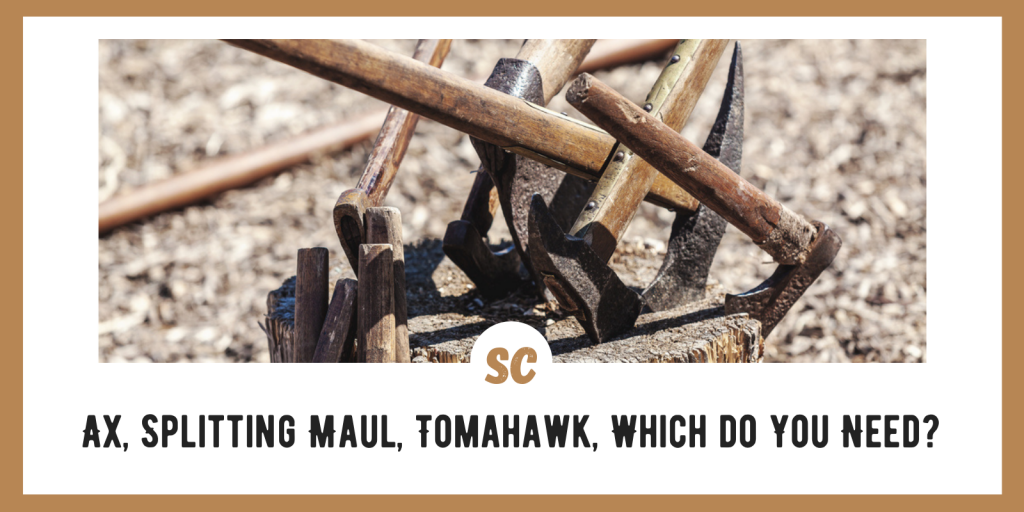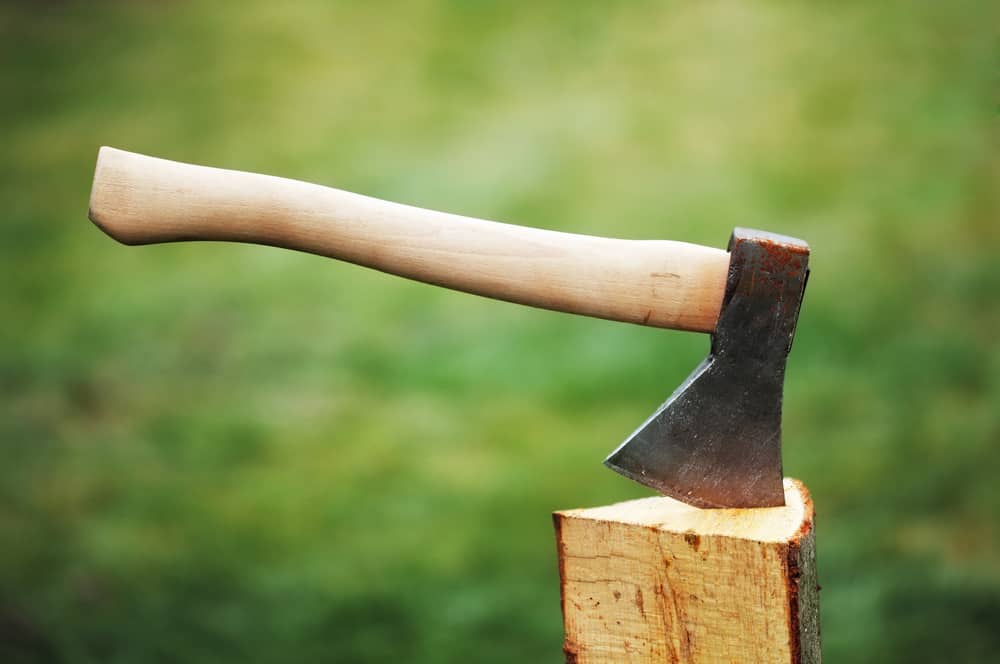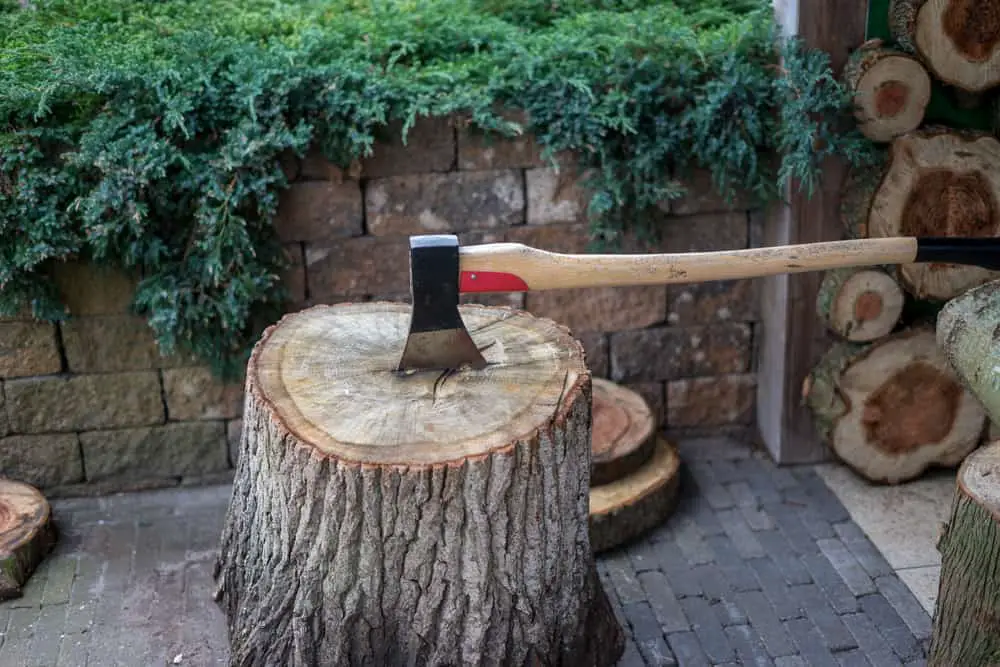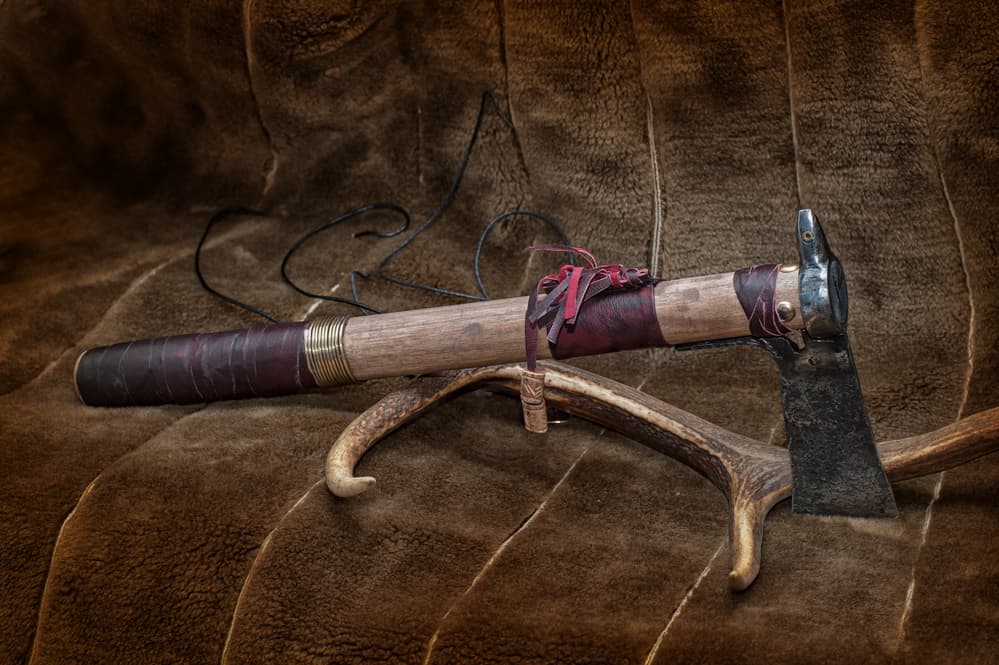Edged tools are among the favorite tools to have and talk about among preppers, survivalists, and outdoorsmen. It doesn’t leave much to the imagination as to why once you understand they are a workhorse and incredibly versatile.
There a lot of different styles of knives to choose from and to the surprise of some, there are almost as many different styles with chopping tools.
Since there are so many variations of chopping heads and shafts, each having their rightful place, this article is going to concentrate on three choppers in a broad sense and how to choose which one you need.
SKIP AHEAD
3 Different Choppers: Ax vs Splitting Maul vs Tomahawk
Ax
Out of the three options on the list, an ax probably has the most variations when it comes to the chopping head.
Traditionally axes have had wooden handles, but modern models also come with metal or some type of synthetic/composite handles that are within the range of 32-36 inches long for common usage, though some can certainly be longer.
Anything shorter is considered more of a “camp ax” which is good for light-duty, intermediate tasks.
Heads weigh in from one pound to three or four pounds on the heavy end.
The profile of the head is somewhat narrow towards the cutting edge which gives it superior cutting and chopping ability.
The downside to this design is that the head can become easily stuck in the wood after each stroke. This causes more effort to be used in resetting the ax after each swing.
Most outdoor axes are lightweight and compact enough to be packable making them suitable tools for long treks in the outdoors.
Ax Pros and Cons
Pros
- Packable
- Easy to use
- Great at chopping
- Can be used for splitting wood
Cons
- Easier to get stuck in the wood
Maul
At a glance, mauls may look like axes but there are some noticeable differences.
Weighing in at five-plus pounds or more, the metal head on a maul is significantly heavier than other choppers on the list. The profile of the head and the cutting edge is also quite different.
Rather than a slimmer profile like an ax, a maul head is much thicker. It may have a cutting edge similar to an ax but the head quickly thickens into a wedge shape.
This is a great feature because it allows the head to be driven into the wood without becoming stuck, like an ax head.
This design combined with its weight makes a maul a great tool for prolonged periods of splitting wood.
The downside of this design is that it makes the maul a poor chopping tool. The wedge shape gets in the way of any swing that isn’t directly straight into the wood and this will cause the head to skip off the wood.
Splitting Maul Pros and Cons
Pros
- Excellent log splitting tool
- Does not get easily stuck in the wood
Cons
- A heavy tool
- Not for chopping tasks
Tomahawk
Many people often confuse tomahawks and hatchets and while they may look similar, they are quite different.
You can think of a hatchet as basically a miniature ax. They are extremely lightweight, compact, and great for light-duty chopping and other tasks around a property or campsite.
Other than the style of the metal head, two characteristics set a tomahawk apart from a hatchet. Their handles are longer and traditionally, the metal head can be removed.
Tomahawks are a multitool of sorts as they can be used for digging, chopping wood, processing wild animals, and used as a fighting tool.
Axes and mauls usually have a flat or rounded back on the side opposite the cutting edge. Tomahawks can have this feature, as well as a spiked back, or a more pronounced flat back used for hammering.
Unlike an ax or a maul, the weight and dimensions of a tomahawk allow it to easily be used one-handed and that is usually how it is used.
Also, while an ax or maul can be thrown, they generally are not. Tomahawks on the other hand have a history of being an edged tool that can be thrown accurately and effectively.
Tomahawks Pros and Cons
Pros
- Lightweight and compact
- Packable
- A removable head can be used as a hand tool
- A removable head makes it easier to replace a broken handle
- Good for chopping, digging, processing animals, and self-defense
Cons
- Not as comfortable or ergonomic for extended, heavy-duty tasks
Which One Do You Need?
My usual answer to questions like this is, ideally you should get all three, that way you will have options.
However, if you do not want to get all three then which one you choose largely depends on what you plan on using it for, where, and the environment. Here are a few examples to help give you a better idea.
Ax
If you plan on spending a lot of time in the outdoors processing wood for medium to large projects, then an ax would be a good choice. It is lightweight enough to be packable and is a good tool for felling trees and processing wood and limbs further.
An ax is a useful tool to have around your property and for extended stays in the outdoors. This is especially true in colder climates where more wood will need to be processed for staying warm.
Splitting Maul
A splitting maul is great as an impact tool and for splitting logs. If you are going to be splitting a lot of wood, especially around your home, it is a useful tool to have around.
However, due to its weight, it is a tool better left at home because you won’t want to haul it on a long trek. Also, its usefulness downgrades when it comes to chopping tasks.
Tomahawks
Tomahawks are a good choice if you want something that can do a little bit of everything. They are good for small to medium-sized projects and their dimensions allow them to easily be carried.
If you want a “jack of all trades” type of tool and will be processing smaller pieces of wood, then a tomahawk is a good choice.
The great thing about a tomahawk is that it is small enough that it and another chopper, like an ax, could both be packed and carried.
Survival Situation
My answer to having all three tools pertains more to normal times and not necessarily a “survival” situation.
In a true survival situation i.e. getting lost in the woods or any other similar scenario, whatever a person has on them will be the best tool.
A splitting maul doesn’t have a place in this scenario because it is far too heavy to be carrying around when a person may need to conserve energy and it is not very good at chopping.
This brings the options down to the ax and tomahawk. In my opinion, both are good to have. They are both good at chopping and are light enough to be carried without much hassle.
An ax will make easier work of larger wood but the versatility and size of a tomahawk are difficult to beat.
FAQS
In my experience, I would say no. If you have the ability and patience to put an edge on a knife, then you should have no problem doing so with these tools.
A good edge can be put on all three choppers with just a few basic tools that include a metal file, a sharpening stone, and a piece of leather.
When looking at sharpening stones, there are handheld stones that are specifically designed for axes. They are called “pucks” and their shape makes them easier to use on an ax cutting edge.
As mentioned earlier in the article, there are three main types of handles to choose from; wood, metal, and synthetic. By in large this is a personal choice, but each material does have its pros and cons depending on how and where the tool is being used.
Traditionally, wood handles are a favorite because they are lightweight, strong, aesthetically pleasing, can easily be customized, and allow the handle to be replaced should it break.
Yes. Generally speaking, traditional tomahawks have wood handles with removable heads whereas tactical tomahawks usually have metal handles and a fixed head.
Also, tactical tomahawks can be shorter and may have other features built into them so that they can be used in other ways, such as a pry bar or a breaching tool.
Lastly, it is also worth noting that tactical tomahawks usually have a black coating on the metal.
Wrap Up
There is an old saying that goes something like, “there is a tool for every job.” I think that is relevant to this topic and tried my best to keep that in mind when writing. I have used all three tools and liked all three as each one has its own job to do.
I hope this article gave you a little more insight into these three tools so that you can make a more informed decision on which one you need.
Thanks for reading and keep chopping!
If you have any questions or comments on these three tools, please feel free to comment in the section below!





